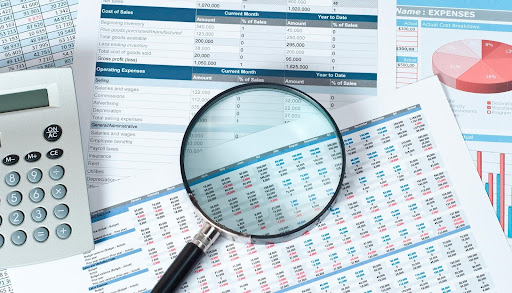Bank Statement Analysis – A Complete Insight
The first thing we hear as soon as we request a loan from any financial institution is a Bank Statement. Be it a business or an individual, Bank statement analysis gives lenders a clear picture of how well the borrower is capable of repaying the amount taken.
For Loan Origination Systems, bank statement analysis is a buzzword. So, let’s dive in to understand more about the bank statement analysis and its relevant importance for all lenders and borrowers.
Bank Statement
A bank statement consists of an account holder’s cash inflows and outflows over a set period. The bank’s operational history is commonly regarded as reliable documentation for assessing the financial health of any account holder. As and when incurred, all sources of revenue, withdrawals, expenditures, credit card payments, overdraft payments, and so on form part of a bank statement. Be it for commercial firms or an individual applying for a loan, the primary document requested for any financial transaction audit or loan process is a bank statement. It can show any information that the examiner needs, to approve loans or to validate financial transactions.

Bank Statement Analysis & Its Significance
The review, breakdown, and examination of a bank statement are known as bank statement analysis. There are a variety of reasons and goals for conducting this check. It is mostly done by retail and commercial banking, financial institutions, investment firms, and auditing organizations. Bank statement analyses are used in commercial and retail banking to evaluate a borrower’s creditworthiness and compare all relevant transactions with other information obtained, such as GST filings or income tax, and financial reports.
The most significant purposes are as follows:
- Determine Creditworthiness: Granting loans makes up the majority of a financial institution’s operational revenue, whether it is commercial or retail banking, an NBFC, or another form of business entity. Before providing financial aid, any institution first assesses the customer’s credit reliability to ensure that the loan will be repaid on time.
- Identify Red Flags: Using this tool, any red flags like large cash withdrawals and cash deposits, overdraft crossing limits, negative balances, cross-verification and bounced checks, all of which can raise a red flag about the borrower, may be quickly identified.
- Fraud Checks: If an organization suspects that fraudulent activities are being carried out, it might execute a bank statement analysis of its merchants or other counterparties. For instance, a string of continuous transactions with big amounts from abroad, or a large volume of cash deposits/withdrawals from an ATM can be the result of fraud. Furthermore, bank statement analysis aids in determining frauds.
- Derive Patterns: This helps in the discovery of banking activity patterns. A bank statement study can be used to forecast and predict withdrawals, bank deposits, and overdrafts, among other things.
- Other important purposes of Bank Statement Analysis include retrieving the address information of the borrower, Benefit-Cost Ratio Analysis, Categorizing expenses like cash assets, cash flow, credit limits, etc.
How do lenders analyze business firms?
Your organization’s cash flow cycle dictates how its goods or services create revenue for ongoing operations, corporate growth, loan repayments, and profit generation. The first thing your lender asks is how you intend to use the funds for your firm. That’s when lenders rely on bank statement analysis. Scroll down to know how this assessment is carried out for approving business loans.
Cash Balance
If the borrower’s bank account statement shows a positive cash balance, it indicates that they have some funds accessible. It also demonstrates how successfully the applicant’s financial flow is controlled. A positive cash balance for several months is easy to label him as a “responsible” borrower as it enhances the likelihood of him repaying the loan in the future. Poor cash holdings on the balance sheet illustrate the applicant’s financial mismanagement and cast a negative light on them. In this part, the lender also analyses the below two things.
- Receivable financing – Receivables are assets that are amounts due to a business – simply put ‘outstanding invoices’. Receivable financing is a loan product. Bankers check for receivables before giving loans against this product. A quick bank statement analysis can confirm whether the borrower has already done some transactions with the debtor or not, which gives a lot of clarity to the lender.
For example, Bankers who specialize in this form of financing may provide a company with a 65-80% advance on its invoices. Bankers will repay the existing balance after charging a fee – which could be around 3-5 % invoice – once the payment was made completely.
- Payable financing – Payable finance is a novel type of credit in which a company borrows funds from a vendor to buy products or services from that vendor. It’s also known as vendor finance or trade credit. Qualifying for payable finance is dependent on the buyer’s credibility.
Deposits
Always make a note of recurring deposit sources on a loan applicant’s bank statement. They represent consistent sources of income for a candidate. Profitable operations and continuous revenue streams from commercial transactions are indicated by large deposits in a company’s bank statements. Consistent regular deposits into a loan applicant’s bank statement raise the likelihood that the loan will be repaid on time each month when it is issued. However, if the previous deposit was made months ago, that is a significant red flag. Lenders should also be wary of unusually large deposits, as well as single or multiple deposits shortly before a loan application.
Withdrawals & Liabilities
Any large withdrawals from the bank account before applying for a loan might raise a red flag for a provider. Frequent withdrawals of identical amounts from a bank account, on the other hand, may indicate a concealed loan, credit card payments, or a recurring obligation that must be paid in a routine. To arrive at a final figure, business obligations are subtracted from the monthly average profit. Any recurring expense that must be met every month qualifies as a liability. The bank statements of the commercial body reflect business liabilities such as hire purchase, office leasing, automobile loans, and so on.
Cash Overdraft
A borrower can use a bank’s cash overdraft option to withdraw additional funds than their profile currently holds. Cash overdraft occurs when an applicant writes a check for resources that are not allocated in their account. Such overdrafts on the balance sheet should raise red flags for lenders. It usually suggests that the applicant has trouble managing his finances and will have trouble repaying the loan.
Bounced penal transactions
Cheques play a significant role in any financial system. A cheque bounce is a failed processing of a disbursed check for a variety of causes. One of the most common causes of a bounced cheque is a lack of funds in the issuer’s account. In addition to imposing charges, the banks reject or invalidate these cheques, often referred to as rubber checks. No check bounces possibly indicate a healthy financial aspect of a firm.
FCU (Fraud Control Unit) Indicators
The FCU indicators give heads-up on the possible suspicious transactions and relevant frauds that have taken place in the financial management of a firm. These indicators help to cross-check transactions like
- Salary credits
- ATM withdrawals
- RTGS funds, that happened on holidays
- Mismatches on amount-balance
- Irregularities in money transfers
- Interest charges
- Negative balance of EOD and so on.
A proper record of all these checks is made to identify the fraudulent activity and counted for the number of triggers, an activity is repeated.
Have a look at the infographic below of what exactly to check for these FCU indicators.
How do lenders analyze Bank Statements for individuals?
The bank statement analysis performed for an individual is very similar to the examination done for a business firm. Individuals have to show a clean record on the cash balance, deposits, withdrawals, and liabilities including the cash overdraft. They also should verify zero cheque bounces and meet the FCU indicator checks. Along with these, an individual applying for a bank loan is also checked for the UPI transactions.
To get their bank statements evaluated, borrowers have to either upload their statements on the lender’s portal (or send it to their account managers), or they can provide the lender with their net banking credentials.
For example: A small-scale business owner applying for a loan is examined for the UPI transactions. These transfers show the number of successful funds, transferred or received in their journey to run the business.
Finally
‘CloudBankin’ does a very accurate automated examination of an applicant’s financial activity. The goal of CloudBankin is to uncover core decisions, to develop a practical index that dramatically reduces the number of non-performing assets (NPAs) and bad credit cases for banks and NBFCs. The program, which comes with Bank Statement Analysis (BSA) capabilities, demonstrates in-depth topical domain awareness from the viewpoint of a credit assessment for a financing decision. It has a very organized section of APIs integrated to perform this task seamlessly for the benefit of lenders. It also generates easy-to-understand visualizations and relevant reports that make credit evaluations to be done effortlessly. Technology has always made remarkable inroads in the lending domain, and lenders are just a click away to get the most of it with CloudBankin.







After smartphone penetration, people are not watching their SMS at all. They use SMS only for OTP related transactions. That’s it.
But What can a Lender see in your SMS after you consent to them?
Lender can see income, expenses, and any other Fixed Obligation like (EMIs/Credit Card).
1) Income – Parameters like Average Salary Credited, Stable Monthly inflows like Rent
2) Expenses – Average monthly debit card transactions, UPI Transactions, Monthly ATM Withdrawal Amount etc
3) Fixed Obligations – Loan payments have been made for the past few months, Credit card transactions.
It also tells the Lender the adverse incidents like
1) Missed Loan payments
2) Cheque bounces
3) Missed Bill Payments like EB, LPG gas bills.
4) POS transaction declines due to insufficient funds.
A massive chunk of data is available in our SMS (more than 700 data points), which helps Lender to make a credit decision.
#lendtech #fintech #manispeaksmoney